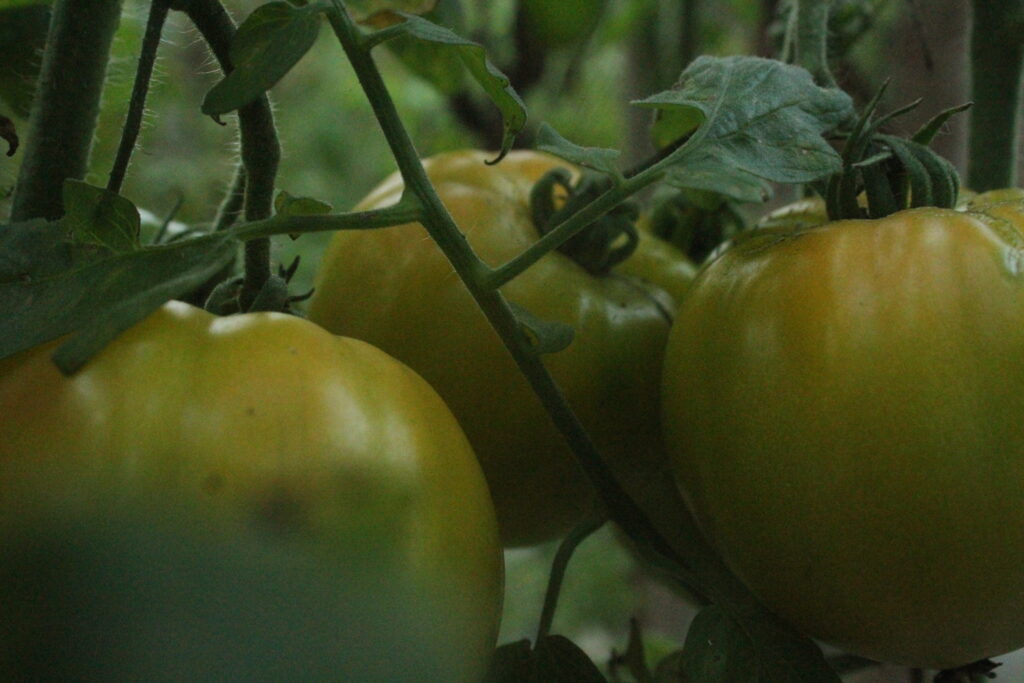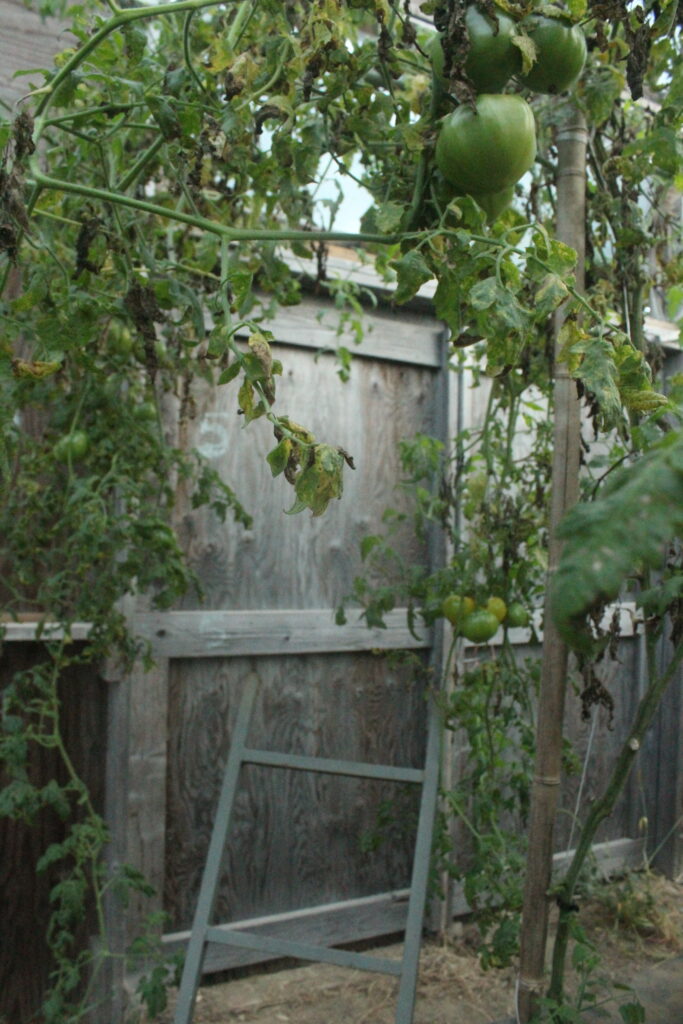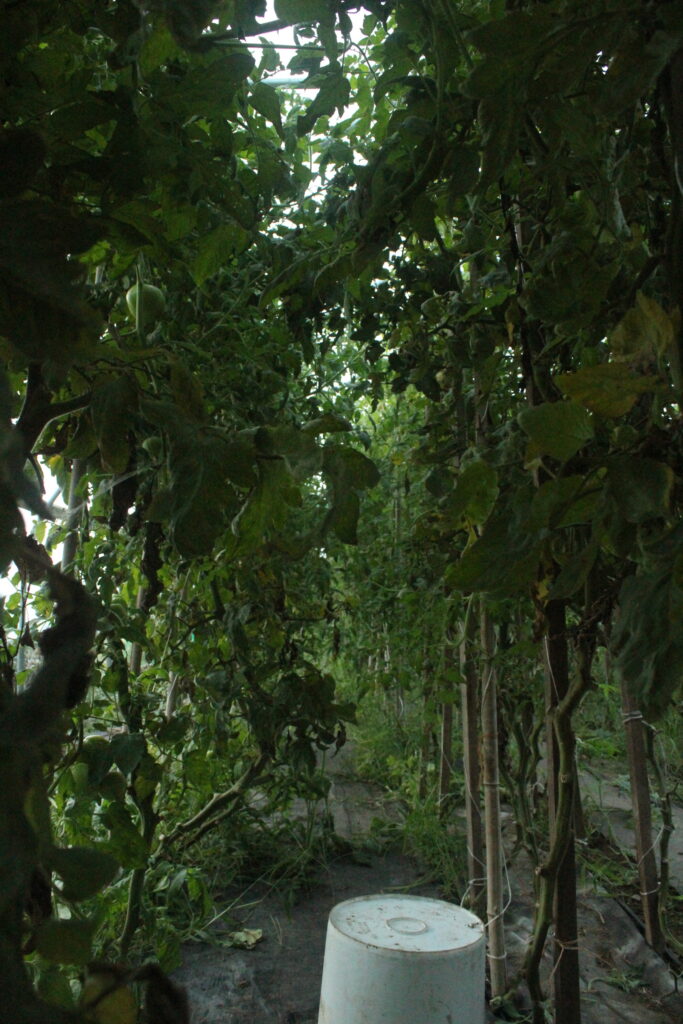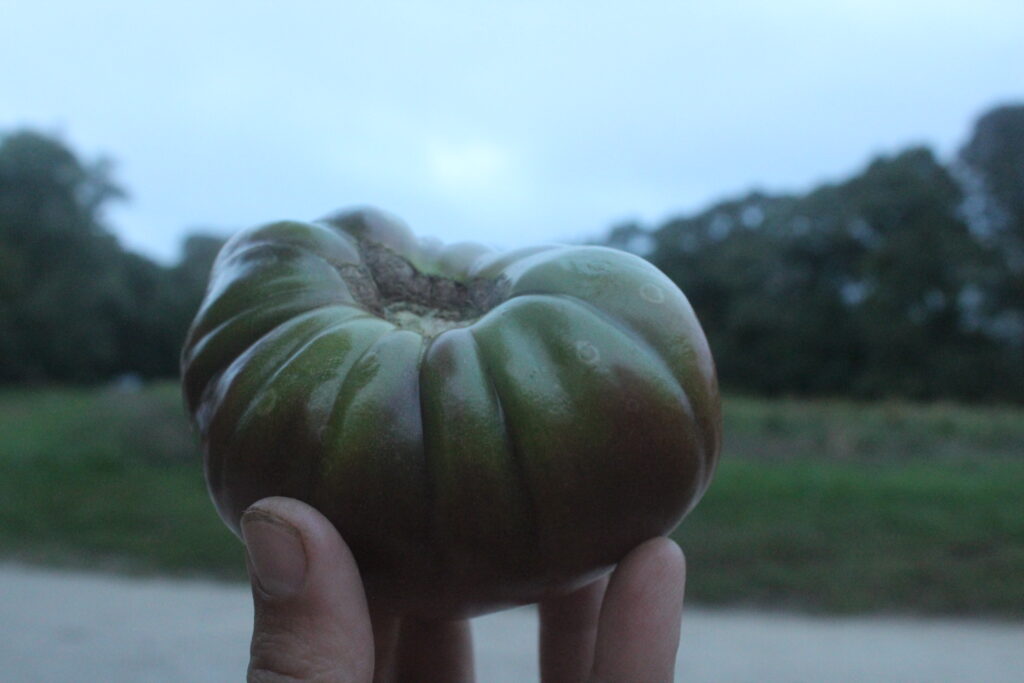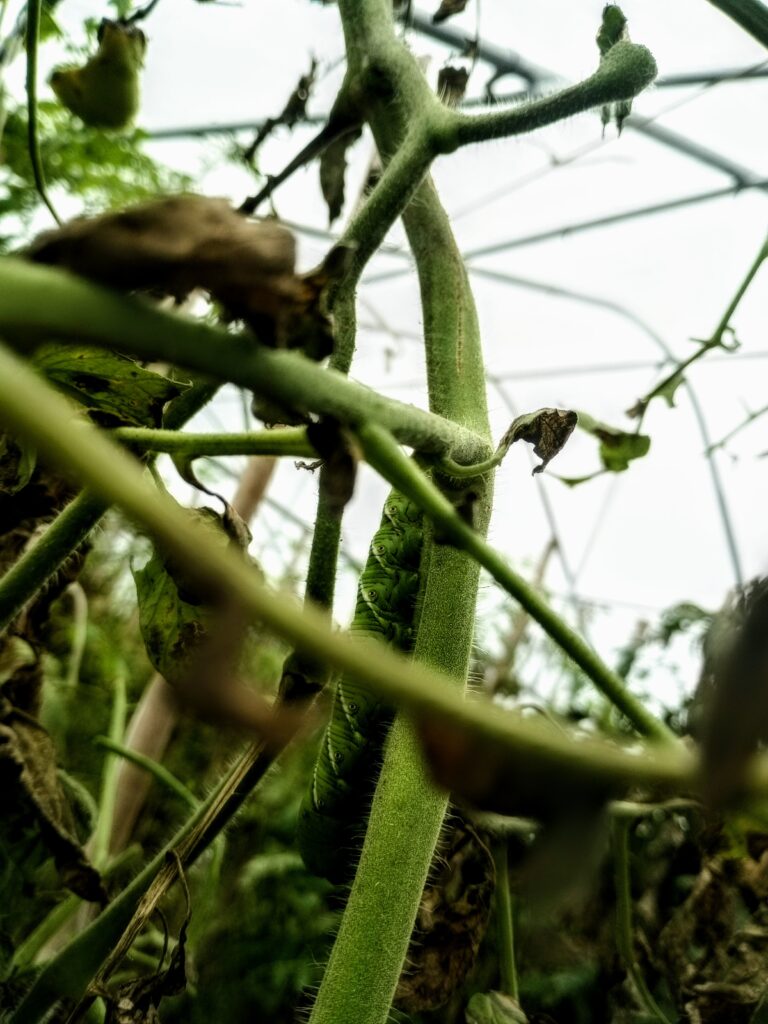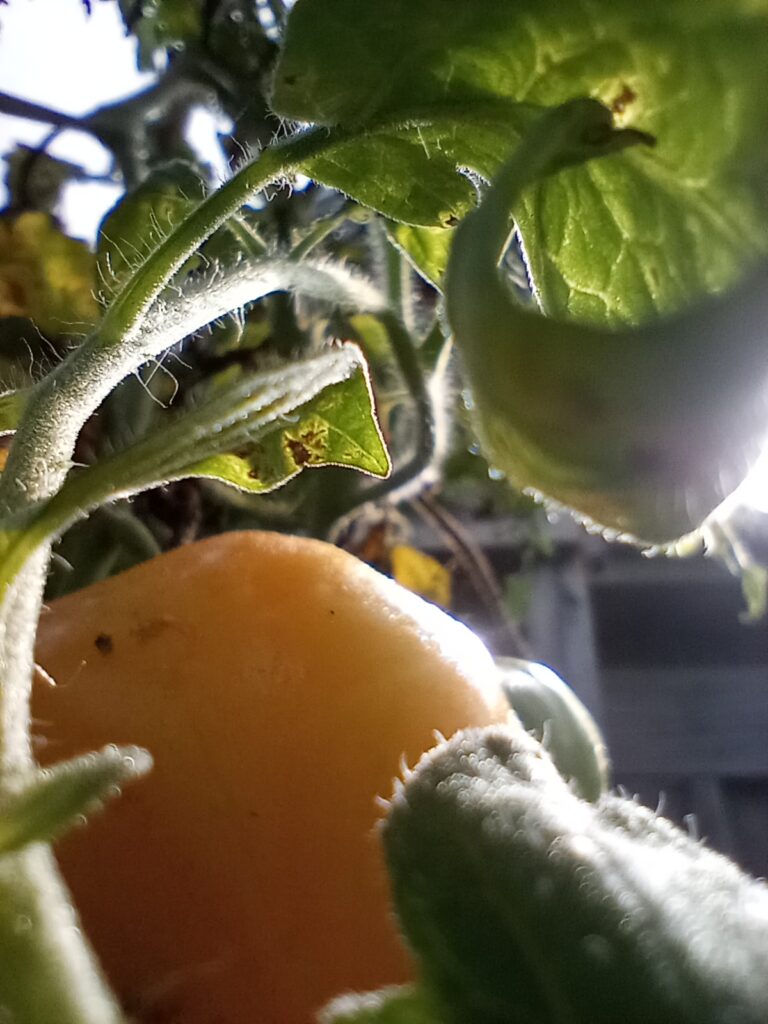~Quietude of the Greenhouse~
Early on at the farm, it became apparent there was something different about the greenhouses. They instigated quiet; it felt wrong to speak above a whisper.
Our seedling greenhouse was the first to which I was offered admission. It was a foggy early morning in mid June. Hanging off the coast of south shore Massachusetts, the clouds here were elusive: they ceased to be individual, matting into one seamless, depthless blue-white tone against which everything else sat in their absence. These sorts of days were seasoned with lavender and peppermint, oils I applied to my temples and my nose, one to distance the headache that accompanied real time greyscale, the other to ward off the seemingly irrepressible melancholy that followed when one seemed to find themselves in the sterile belly of the whale.
We were seeding squash of all kinds– with sweet epitaph names like honeyboat– and about seven different varieties of lettuce. My coworker Charlie, a short, young nonbinary human with an award-winning smile, stood across from me. We were both deep in concentration so as not to lose any small seeds from our trying palms. Between us on the table were trays of fresh, loose soil and an overflowing small cabinet drawer full of seed packets.
Charlie was the first person to greet me on my first day. They smiled, a little indentation to the right of their bottom lip, asking me if I’d like to sit with everyone at the picnic table under that large oak tree over there, gesticulating towards the grassy hill beside the root cellar. They were inclusive and gentle, their energy warm and stimulating like cinnamon. Behind them pinching squash seeds into little cubic squares of soil, trays of basil seedlings had started to sprout, quivering at the slightest movement. We worked in silence.
My second excursion into one of our greenhouses occurred later that week. A few farmers were ushered into the third of three large greenhouses that stood side by side in a willowy formation. The wind had picked up and in the breeze, the shrink wrap flapped against the skeletal bars of High Tunnel 3. This is where the tomatoes rested.
Five hundred clones of various tomato varieties stood lined up like school kids, about two feet tall and already developing their own opinions about things. I was immediately entranced, my breath caught somewhere in the weighted heat around us.
On hands and knees, we weeded purslane, galinsoga and lambs quarter, among other green vines from the soil. In their soft, gnarled bodies, the tomato youth seemed simultaneously indestructible and painfully fragile.
Hugged on either side by rows of tomatoes, Paul a young German artist who would become a close confidant, and I crawled forward, pulling up shallow roots. I asked him, after his four seasons of being on the farm, what his favorite plant was. He shrugged and said, “I don’t know, but good things happen beside tomatoes.”
Soon after, our boss Kofi began hauling in burlap sacks that smelled like heaven. He said he had collected them from a dumpster outside a local coffee roaster, sacks and sacks of coffee shells. We added a thick layer like a comforter over the freshly weeded soil, the sweet-smelling mulch tucking in the rough, velvety stems of the tomatoes, not yet tall enough to lean into their paired stakes.
~A Formal Introduction to Lady Tomato~
A week later, after our morning breakdown, Kofi told me I would be helping Sue, a resident employee of presumably over twenty years, who would quickly weasel into my heart as one of my favorite farm personalities. I tripped over myself in an attempt to keep up with him as full-bodied steps carried us to HT3. He spoke gruffly over his shoulder, “I thought you might be good at this because you’re detail-oriented”. I imagined this was an allusion to my first day, where he had to spend fifteen minutes explaining how to pull up spinach to sell, as I peppered him with an array of questions so particular I couldn’t repeat the performance if I tried.
Entering the high tunnel, the tomatoes were already visibly taller. Kofi explained that they were all indeterminate, meaning they could grow, if prompted properly, to the ceiling and theoretically, to the great beyond. The outer rows were bred to have more disease resistance, the inner rows heirlooms of various varieties, wielding poetic names such as “sun gold” or “cherokee purple”. He explained that the main stem of a tomato plant was called a leader and as time went on, new leaders would grow out of the armpit, or axis, between leaves and the main stem. These were called suckers.
A few weeks before I arrived, they had constructed support beams running horizontally about seven or eight feet above ground level in the high tunnel. Perpendicular to these, they drove five hundred stakes into the ground, each with its own line attached and twisted around it. Circular clips (aptly called tomato clips) wrapped around the main stem (or leader) and attached to the line around the stake. This gently and efficiently kept the tomato plants growing upward, not out and down as their vine legacy, untended, would pursue.
Kofi and Erin (Kofi’s leading counterpart and partner on all fronts) collectively decided it made sense to maintain two leaders per plant at most, so they didn’t suffocate themselves of sunlight and oxygen. I was to prune all other suckers, leaves that touched the ground, and move their clips up the stem.
To some extent, people have been in relationship with tomatoes for millenia. The Aztecs were the first documented instance of humans cultivating tomatoes, though research suggests they have been farmed for at least 7,000 years. In the colonized Americas, they didn’t become a part of contemporary life for another few hundred after that.
Early records of market sales in 1812 New Orleans indicate it was already a popular crop, and food historians generally agree that by the 1800s, the tomato was widely used and enjoyed in the Southern United States. Meanwhile, New England settlers maintained skepticism of the nightshade fruit until the turn of the next century. This juxtaposition, of regimented growth and relatively new appeal, allowed the juices of novelty to stay fresh on my mind, getting to know these old beings that had simultaneously been with and apart from humanity for a long time.
In the weeks that followed, HT3 became a jungle. There was something about the abundance of healthy life, so lovingly tended to, that hung in the air like nectar. For what felt like the first time in my life, I watched a plant grow from adolescence into adulthood.
I reveled in the opulently small details of change that erupted. How quickly they made new leaders both at the bottom of the stem beside stubby aerial roots and among their top heavy growth. Their fresh starts were a subdued purple blending into the fresh green, small hairs soft and easily brustled, covering the new growth in what looked like a white film. Seemingly within mere days, they grew into full-fledged beings.
~The Beginning, No Rain~
June left and took with it all traces of rain. Twice in the entire month of July did it come, and only for a sprinkling of fifteen minutes each time. Once was on July 24th somewhere between 3 and 4 a.m., the other July 29th at 12:15 a.m. I say this with such confidence because the sound of the rain became so foreign that the smallest drops outside my loft’s window woke me up. The sound was so comforting, and so haunting. It was already growing into something rare, that sound. I learned that the rain was not something I could take for granted, even in the lush green of New England that pulled it out of the sky. Drought I had restricted for those faraway places like California and India, but all realities evade those straight lines of boundaries set by people and not nature. Climate change knows no borders.
In HT3, the drip lines were constant alongside rising food inflation. At least it made sense. With no water, greenery was an elevated commodity. Within a few weeks, the five hundred tomato plants grew to heights above my head.
Part of their main tending was looking below for forgotten tomato clips and saving them the distress of growing over or through their latch mechanism in discolored bulges. Something about the anthropomorphism of nature being more human the larger it gets, once the plants stood next to me– sometimes high enough to be a pleasing date– I started to feel strange. I looked under their skirts of lower leaves, large enough to be an elephant’s ear. I started asking them in my mind, if it was okay. It was a funny matter, considering I would have to do it even if I did not feel their consent echo back to me. I also carried the underlying knowledge that they benefitted from my invasive tending.
I realized this was my puritan upbringing. Plants like to bump uglies with us, their pollen a stain of hope more than desire as we, hosts and friends akin, carry their potentiality out into the world with us. There are no words to describe the smell that lingers in thick yellow layers on your fingertips after handling tomato plants.
~July & the Hornworm~
As July unfurled, the tomato hornworms began their destruction in full force. At first, I saw them maybe an inch long, bright green, thin, unfrightening. Tomato leaves began to take a beating, nubs of stems all that was left in the aftermath of their boundless feasting. They grew inches in days. I was told to step on them, squish them, kill them at all lengths.
The markings on the side of their gelatinous bodies were fine-lined eyes– yellowed irises, small black pupils, even where the light might hit those eyes and bounce off their coloring artfully embellished. Alternating between eyes were long white lines, stretch marks or racing stripes I’m not sure which. On their head extended a curved red horn about a third of their body length.
I admit to a gruesome crime: earlier on, especially the larger they wiggled, I could not bear to kill them outright. Instead, I’d leave them precariously under a large bucket or pinned against a rock and the ground. Their many eyes would squirm and fold against the pressure, but their green eyes never quite focused on me.
This way, I told myself, maybe against all odds they’d find a resolution, wedge their way to safety, offending gravity and fate, making their way to the promised land of pupation beneath tilled soil. This changed somewhat as the tomato hornworms grew threefold, both in numbers and size, and the gangly tomato teenagers I had been feeding, propping, supporting, began to hang like plastic Halloween skeletons with all their leaves consumed. They became a shadow of their former glory.
I had heard from the beginning of early blight, and between suckering each plant, I learned to sanitize my clippers. At first, it felt counterintuitive to cover my blades with alcohol in order to preserve the plants, but it seemed to save them at least a premature death. We began cutting all leaves on the last two feet of the main stem.
One day, Justin caught a five spotted hawkmoth and offered it to me. “I already have way too many,” he shrugged and grinned– he was a bug guy. I learned this elegant white moth came from the amorphous tomato hornworms. It was hard to wrap my brain around and the more I learned about the process, the stranger still it seemed. In the article “Metamorphosis Explained”, Liz Langley states that 75% of all known insects go through metamorphosis.
She further extrapolates that they go through either complete (holometabolism) or incomplete (simple) metamorphosis. Tomato hornworms underwent the former, which meant they have four distinct life stages: egg, larva, pupa, adult. True to their gluttonous destruction in HT3, the sole purpose of their larva stage (the hornworm) is to eat like there’s no tomorrow and molt five times. Each molt is called an instar.
Most staggering was the metamorphic stage, where different insects create an unbelievably diverse assortment of cocoons. I assumed all metamorphoses occurred like the one my third grade class endeavored with caterpillars threading their silk, but insects are engineers of all materials. The honeybee will enclose itself into a cell in the honeycomb, the eastern firefly burrowing underground. More complex is the caddisfly, who builds a sealed structure from rocks and shells in the river and must swim to the surface upon its first breath as adult.
For the tomato hornworm, once the eggs hatch, they live for three to four weeks consuming all they can before burrowing, like the eastern firefly, for their pupal stage. This burrowing can last a few weeks or six months if the variables are not just so. Their time as a powdered geisha of a hawkmoth (also referred to as the Sphinx Moth) is a precious ten to thirty days.
Once adults, most insects’ sole motivation is to mate. The other components of living in a corporeal body are so secondary they sometimes emerge from the chrysalis without even a digestive system. This is reflected through the Luna Moth who does not even have a mouth, though others follow suit– choosing sex as food every time, such as the firefly and the crane fly.
Such a salacious life, I thought, wandering through the tomato jungle, adjusting the mobiles of hanging vines and pulling off sticky, gelatinous green bodies. To consume your weight over the course of a few weeks, desecrating the plant that held your birth, burrowing into the dark unknown only to emerge full grown for the most temporal of weeks, an insatiable, urgent need to continue the life force in another body. Blood, sex, drugs and violence had nothing on these cretins: lecherous, slothlike, knowing nothing of apology in the dreamscape of tomato paradise and an existence elusive to ethics.
‘Maybe if I lived my life to its debaucherous best . . .’, I pondered, continuing to pull hornworms from the leaves, admiring their near flawless camouflage. ‘Maybe if I consumed honey sin and desperate touch like my life depended on it’, I thought, ‘maybe in my next life I’d be a tomato hornworm.’
~The First Tomato~
It was the last week of July, and the heat was scalding enough that I imagined it cracking open, the air becoming air again, pressure from the other side sucking out the static cloud we worked in. The cucumbers soured and dried on crumpling vines. Kofi said he had added too much loam to the soil, and the heat didn’t help. In the lower fields, the soles of my feet burned on the acrid soil as I walked down the rows. Trying to evade the middle rows of celery brushing against my exposed calves, I pulled along overflowing crates of eggplants. I remember returning from the lower fields to the farm stand one day and feeling as though I was seeing the landscape for the first time in weeks: everything was yellow. The grass and the shrubs had withered into dry exoskeletons of what they once were. It seemed the landscape had frozen in a breeze, the undergrowth caught in a final unmoving gust. With that slow epiphany came the chilled discomfort that maybe this pond I swam in was actually a pot, and in it the water had started to boil around me.
I commented out loud on my surprise and Erin sighed beside me. “Drought year.”
In HT3, three tomatoes had started to brighten from green to the palest pink and red. Most of the plants were thriving upward in peacock feathers of green leaves and heavy fruits. It was only at the back that one stand of plants was starting to struggle, their leaves yellowing with blight, their veins turning a crispy brown. It seemed to be that way: with every euphoric burst of life something was dying quietly beside it. Making room, saying little.
That weekend, I had plans to make no plans. Erin and Kofi were away for the following week; it was their one solace in a season of no sleep for farmers. My friend was coming over, but running late. I smiled to myself, thinking about how I might as well go to my grocery store, the fields, and bring back something nice for her. This was the part of the season where everything bloomed, all the vegetables hung swollen and sweet from the stalks and it seemed the world was dripping in abundance.
Walking up the pasture road, the summersweet bloomed in fragrant bunches beside it. The marsh across the way looked more like mud than water, but it still thrived with the funny honks of great blue herons, of crows’ wings slicing through the air, of small chickadees providing the latest gossip of the neighborhood. I was part of their storytelling, their small chirps increasing and getting louder as I got closer, letting the rest of the marsh know that there I was. I liked being part of their talk.
I went to the flower fields and picked a sunflower, its head drooping with petals a brooding red, its center underneath the black seeds a thick mustard yellow. Unintentional herbs popping up from old compost lined some of the greenhouses, and I rubbed their leaves, cupping my hands over my nose and mouth, breathing it all in deeply. Shiso, sage, anise hyssop. Sometimes nothing made sense, and sometimes everything did.
This was one of those days, the sun’s heat sedating me, the sounds, smells and sights of so much life leading me to think of nothing else but thank you thank you thank you. Meandering, I sang my praises to the basil in High Tunnel 2; they stood up to my knees, their branches extending at symmetrical points along the stem two at a time, their smell a key to my childhood.
I uncorked the door to HT3. The three tomatoes I had been watching with hawk eyes had all blushed into their final life stage. All three were heirlooms, their wrinkles like the showy folds of curtains at a theater, so beautiful it required balconies to watch their unfurling. Two were cherokee purple, the variety that would become my most beloved, their hue a dark magenta, their crowns a brooding green. The third I couldn’t tell you, its skin a rainbow of red, orange, yellow and fresh light green. The array of different stages of growth color indicated the plant had fed its sugars to this fruit rather erratically. It would not reach its full color on the vine before half of it began to rot.
I picked it, its smell divine, like water running between rocks, like moss and sex and sunlight on one’s skin. I brought it back to the cabin, holding my bounty with shaky hands, thinking about how I had watched this tomato become. It was like climbing into a mother’s belly and watching her satiate the next generation of life. A simultaneously selfless and self-full act, this tomato wanting their seeds to feed the next stage, and also, knowing they wouldn’t be here for it.
I placed the tomato on a stump on the front stoop, the sun cascading over its curves, an orange glow coming through the trees as daybreak emerged. It took a few days to tan its way to full red and yellow, and when I took a bite, I knew it was the freshest thing I’d ever taste.
